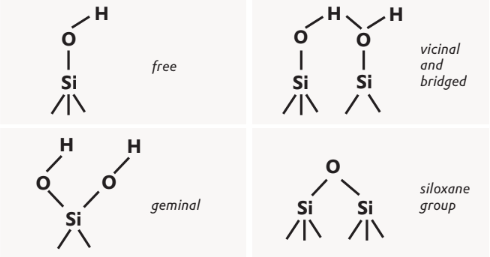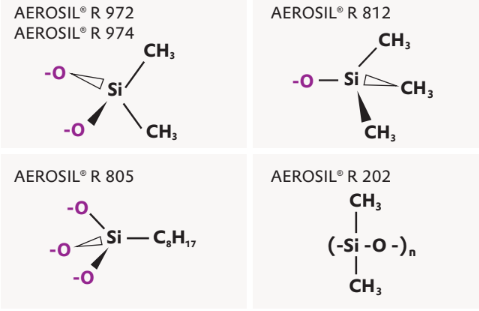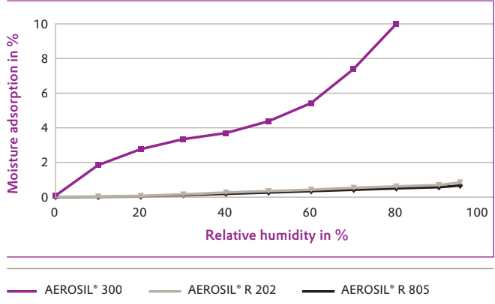Enhanced TDS
Knowde-enriched technical product data sheet
Identification & Functionality
- Chemical Family
- Chemical Name
- INCI Name
- CASE Ingredients Functions
- Composite Materials Functions
- Cosmetic Ingredients Functions
- Fluids & Lubricants Functions
- Plastics & Elastomers Functions
- CAS No.
- 67762-90-7
- Technologies
- Product Families
Features & Benefits
- Benefit Claims
- Labeling Claims
- CASE Ingredients Features
- Fluids & Lubricants Features
- Materials Features
- Product Features
- The silicone oil treatment guarantees the marked hydrophobia of the product
- Highly efficient effect in the thickening and thixotropy of complex polar liquids, such as those based on epoxy, polyurethane, or vinylester resins
- With silicone oil treatment, AEROSIL® R 202 offers a tailor-made chemical surface treatment.
- The high hydrophobicity of PDMS-treated, small particle AEROSIL® grades makes them particularly effective for achieving a high tribo-charge.
- At the same time, PDMS-treated, small particle AEROSIL® grades maintain good flowability.
Applications & Uses
- Markets
- Applications
- Compatible Polymers & Resins
- Fluids & Lubricants Type
- Fluids & Lubricants End Use
- Plastics & Elastomers End Uses
- Plastics & Elastomers Processing Methods
- AEROSIL® Fumed Silica in Lubricating Greases
AEROSIL® fumed silica helps to build a stable matrix to increase viscosity and suppress oil separation in lubricating greases. It can be used in the following systems:
- In non-soap greases, used in high-temperature applications up to 230° C as well as for extreme-pressure and multipurpose greases.
- In soap greases, thickened by fatty acid soaps of lithium, calcium, sodium or aluminum, AEROSIL® fumed silica can be used to further improve the performance of the lubricating grease.
- Hydrophilic fumed silica provides optimized thickening effects in non-polar oils.
- Hydrophobic fumed silica provides viscosity control and increased water repellency in semi-polar to polar oils.
- The surface area of the silica and the volume fraction of the silica in the fi nal mass play a role in the long term storage and heat stability.
- Cable Gel Applications
Use of AEROSIL® fumed silica for cable gels gives excellent performance when it comes to shear-thinning, providing quick recovery and the gel does not require heat to be applied. AEROSIL® fumed silica improves properties of oil-based filling compounds for wire and cables to protect fibers (e. g. optical fibers) as it:
- Supports to isolate sensitive optical fi bers from external forces
- Protects the fi bers from moisture
- Provides thickening to help the gel to stay where it is placed
- Helps to form a seal to keep out contaminants like dust, dirt and water
- Is non-conductive / does not negatively infl uence di-electrical properties
f - Applications
- Thickening and thixotropy control of adhesives and sealants for fiberoptic cables
- Thickening and thixotropy control of epoxy and vinylester resins
- Booster silica for defoamer formulations
- Anti-sedimentation aid for fillers, such as chalk or quartz powder
- Additive for formulation of anti-corrosion systems
- Improves flowability of powders
- Enables achieving of a high tribo-charge
- Lubricating Grease Applications
The use of AEROSIL® fumed silica is recommended for lubricating greases used in industrial applications, automotive, electrical as well as food grade.
- Electrical - Offers rheology control as well as water resistance.
- Industrial - Offers rheology control as well as excellent oxidation resistance against water and chemicals.
- Automotive - Offers rheology control as well as excellent oxidation resistance against water and chemicals.
- Food - Hydrophilic AEROSIL® are generally recognized as safe (GRAS; direct food contact). Offers rheology control as well as water resistance
Properties
- Physical Form
- Appearance
- Fluffy white powder
- Physico-Chemical Properties
Value Units Test Method / Conditions Unit Weight (Netto) 10 kg - HCI Content⁸,¹¹ max. 0.025 wt % - TiO₂ Content⁸ max. 0.030 wt % - Fe₂O₃ Content⁸ max. 0.010 wt % - Al₂O₃ Content⁸ max. 0.050 wt % - SiO₂ Content⁸ min. 99.8 wt % - Carbon Content 3.5 - 5.0 wt % - pH Value⁵ (4%, Aqueous dispersion) 4.0 - 6.0 10 wt % - Loss on Ignition⁴,⁷ (2h at 1000°C) 4.0 - 6.0 wt % - Loss on Drying³ (2h at 105°C, when leaving the plant) max. 0.5 wt % - Tamped Density² 60 g/l - BET Surface Area (BET¹) 80 - 120 m²/g - Behavior Towards Water Hydrophilic - - - Note
1 - According to DIN 9277
² - According to DIN EN ISO 787/11, JIS K 5101/20 (not sieved)
3 - According to DIN EN ISO 787/2, ASTM D 280, JIS K 5101/23
4 - According to DIN EN ISO 3262-20, ASTM D 1208, JIS K 5101/24
5 - According to DIN EN ISO 787/9, ASTM D 1208, JIS K 5101/26
6 - According to DIN EN ISO 787/18, JIS K 5101/22
7 - Based on dried substance (2 hours at 105 °C)
8 - Based on ignited substance (2 hours at 1000 °C)
9 - Special moisture-protective packaging
10 - in water: methanol = 1:1
11 - HCI-content is a part of ignition loss
12 - Packaging of densed material: 20 kg- Note
* ex plant
Regulatory & Compliance
- Certifications & Compliance
- Chemical Inventories
Technical Details & Test Data
- Test Methods
- AEROSIL® fumed silica is a highly dispersed, amorphous, very pure silica manufactured by high-temperature hydrolysis of silicon tetrachloride in an oxyhydrogen gas flame. The primary particles formed in the AEROSIL® process are virtually spherical and free of pores.
- During the formation of the primary particles, aggregates are formed which further accumulate into agglomerates. Under shear, these agglomerates can be returned back into smaller aggregates.
- Siloxane and silanol groups are found on the surface of the AEROSIL® particles. This latter type of functional group in particular is responsible for the hydrophilic behavior of untreated AEROSIL®. Figure shows the surface groups of hydrophilic AEROSIL® grades.

Surface groups of hydrophilic AEROSIL® grades.
Figure below provides a summary of these and highlights the difference between them and hydrophilic AEROSIL® grades according to the schematically represented surface groups. All hydrophobic AEROSIL® grades bear the suffix "R" to indicate their water- repellent character.

Surface groups of hydrophobic AEROSIL® grades.
The hydrophobic nature of aftertreated AEROSIL® grades compared with AEROSIL® 300 can be illustrated by means of moisture adsorption in increasingly humid conditions. Figure below shows the corresponding isotherms.

Adsorption isotherms of various AEROSIL® grades at room temperature (small samples).
- AEROSIL® Fumed Silica
- AEROSIL® fumed silica is a highly dispersed, amorphous, very pure silica manufactured by high-temperature hydrolysis of silicon tetrachloride in an oxyhydrogen gas flame. The primary particles formed in the AEROSIL® process are virtually spherical and free of pores.
- During the formation of the primary particles, aggregates are formed which further accumulate into agglomerates. Under shear, these agglomerates can be returned back into smaller aggregates.
- Siloxane and silanol groups are found on the surface of the AEROSIL® particles. This latter type of functional group in particular is responsible for the hydrophilic behaviour of untreated AEROSIL®. Figure shows the surface groups of hydrophilic AEROSIL® grades.

Surface groups of hydrophilic AEROSIL® grades.
Figure below provides a summary of these and highlights the difference between them and hydrophilic AEROSIL® grades according to the schematically represented surface groups. All hydrophobic AEROSIL® grades bear the suffix "R" to indicate their water- repellent character.

Surface groups of hydrophobic AEROSIL® grades.
The hydrophobic nature of aftertreated AEROSIL® grades compared with AEROSIL® 300 can be illustrated by means of moisture adsorption in increasingly humid conditions. Figure below shows the corresponding isotherms.

Adsorption isotherms of various AEROSIL® grades at room temperature (small samples).
Packaging & Availability
Storage & Handling
- Shelf Life
- 2 years
- Storage Conditions
Recommend to store the product in closed containers under dry conditions and to protect the material from volatile substances. AEROSIL® R 202 should be used within 2 years after production.